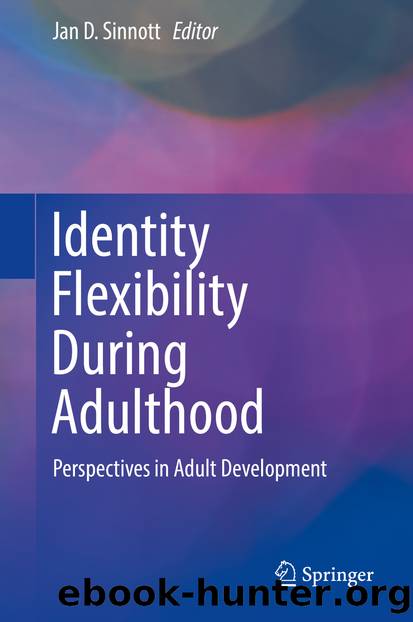Identity Flexibility During Adulthood by Jan D. Sinnott

Author:Jan D. Sinnott
Language: eng
Format: epub
Publisher: Springer International Publishing, Cham
Results and Discussion
Our analysis focuses on participants’ answers to two questions. The first question allowed participants to write in the label or labels that they endorsed for their own gender identity. The second was an open-ended question in which participants were asked to describe their gender identity.
Gender Identity Labels
Participants self-identified with a range of gender identity labels. This data was self-generated, and participants were allowed to describe their gender identity in a way that felt authentic to themselves. A percentage of gender variant (20.9%) and agender (25.0%) participants endorsed multiple labels when providing their write in gender identity. For example, one participant responded, “I use the words genderqueer, gender fluid, trans, transgender, gender non-conforming, and occasionally transmasculine to refer to myself.” (genderqueer)
Table 10.2 provides the frequency of labels endorsed by participants across gender identity (gender variant and agender). Labels fell into five primary categories: (1) gender labels using binary terms (e.g. woman, man, masculine, femme), (2) gender labels using nonbinary terms (e.g. androgynous, non-binary, pangender), (3) gender labels using fluid terms (e.g., fluid, gender variant , genderfluid), (4) gender labels using agender terms (e.g., genderless, agender, non-gendered), and (5) gender labels using trans terms (e.g., trans, transgender, transmasculine). It is important to note that although both gender variant and agender participants use labels that fall into all five of these categories, there are unique patterns of usage across gender identity. For example, 58.1% of gender variant as opposed to 33.8% of agender individuals used nonbinary labels while 3.9% gender variant and 76.5% agender individuals used agender labels. Because there are clear patterns in the way gender variant and agender individuals use gender labels, in the remaining analyses, we include direct quotes from the participants accompanied by their self-identified labels as context for understanding their varying perspectives .Table 10.2Frequency of gender identity labels by group
Download
This site does not store any files on its server. We only index and link to content provided by other sites. Please contact the content providers to delete copyright contents if any and email us, we'll remove relevant links or contents immediately.
Rewire Your Anxious Brain by Catherine M. Pittman(18478)
Talking to Strangers by Malcolm Gladwell(13121)
The Art of Thinking Clearly by Rolf Dobelli(10124)
Mindhunter: Inside the FBI's Elite Serial Crime Unit by John E. Douglas & Mark Olshaker(9092)
Becoming Supernatural by Dr. Joe Dispenza(8025)
Change Your Questions, Change Your Life by Marilee Adams(7551)
The Road Less Traveled by M. Scott Peck(7465)
Nudge - Improving Decisions about Health, Wealth, and Happiness by Thaler Sunstein(7449)
The Lost Art of Listening by Michael P. Nichols(7353)
Mastermind: How to Think Like Sherlock Holmes by Maria Konnikova(7147)
Enlightenment Now: The Case for Reason, Science, Humanism, and Progress by Steven Pinker(7078)
Win Bigly by Scott Adams(7025)
The Way of Zen by Alan W. Watts(6442)
Daring Greatly by Brene Brown(6359)
Big Magic: Creative Living Beyond Fear by Elizabeth Gilbert(5544)
Grit by Angela Duckworth(5442)
Ego Is the Enemy by Ryan Holiday(5217)
Men In Love by Nancy Friday(5100)
Altered Sensations by David Pantalony(4995)
